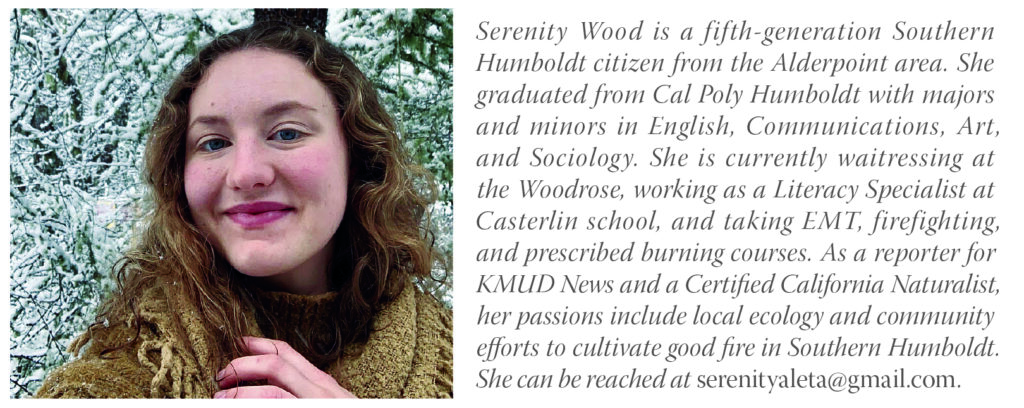Living With Fire
Native Health in Native Hands, Organizing for a Changing World
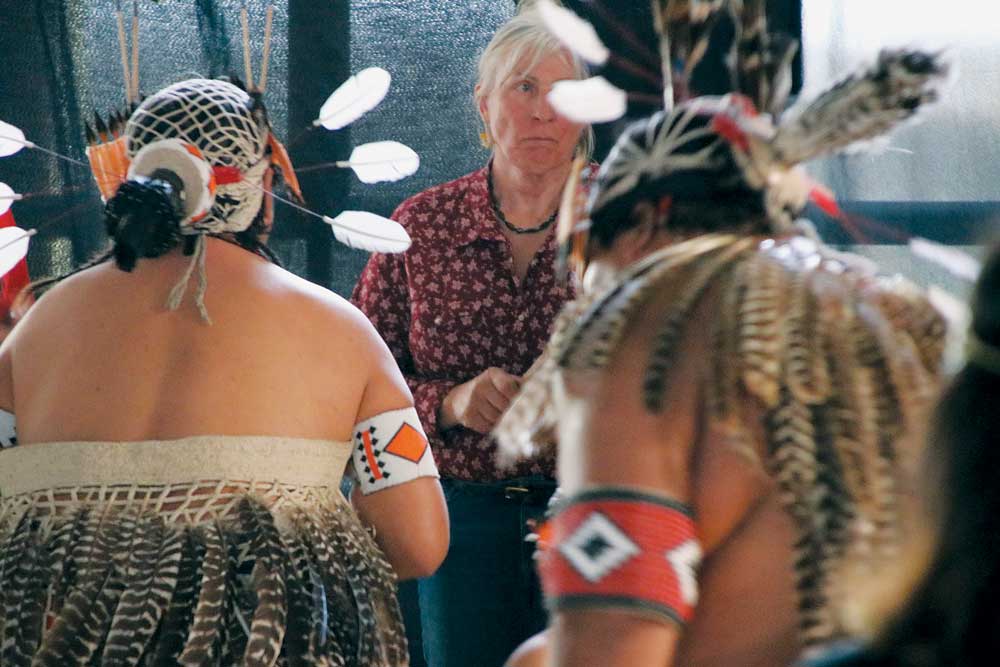
By Serenity Wood
During this era of ecological crisis, how do we return more stewardship of the land to Indigenous peoples? Tribal cultural revitalization and environmental protection efforts are working towards this goal in Southern Humboldt through Native Health in Native Hands.
“Awareness, love, compassion, and gratitude is what we are all feeling as we teach each other,” says founder and executive director Perry Lincoln. His collaborative bridge-building efforts bore abundant fruit in 2023. “In one year,” he smiles, “we have agencies, locals, and Native people working and planning together.”
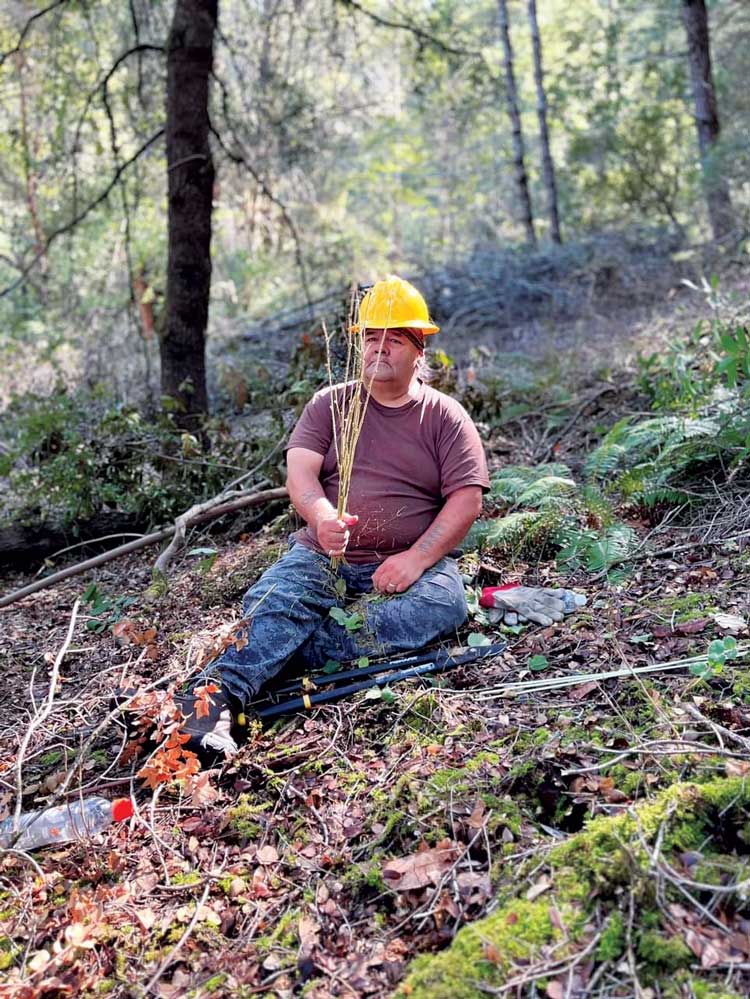
Photo courtesy Perry Lincoln
Native Health in Native Hands supports community connections to ancestral homelands, arts, languages, and culture to accomplish Indigenous healing. Perry Lincoln has Kinest’e (what Wailaki people called themselves in their own language before first contact), Yuki, and Pomo ancestry. Lincoln is working to boost Native access to traditional ecological knowledge, which was used to caretake the land for millennia. He believes we should extend our sense of community to include all life forms—plants, animals, human beings, rocks, and rivers—for a politics of place where we are deeply accountable to our communities, our neighborhoods, and our home. Lincoln hopes to inspire others so we can change our conceptions of the land from ownership to commitment. He insists that we carry a reciprocal responsibility to protect and nourish our environment and surroundings: “All the human beings have an obligation to work with the land, for the land. And in return, the land provides for us.”
In honor of matrilineal Native societies, and with support from Trees Foundation and other partners, Native Health in Native Hands hosted an all-Native-women panel at Redway’s Mateel Community Center on January 15, 2023, to educate the community about the need to bring back Native-led “N-Shong Konk” or “good fire” in our region. Fire is essential to a diverse, healthy ecosystem of understory vegetation. However, using fire in a beneficial way is a sensitive process given the past 150 years of fire suppression. Cultural fire experts Diana Totten, Margo Robbins, Kathy Mccovey, and Elizabeth Azuz described fire as a cleansing tool, subtracting fuel and invasive species, but also a creative tool, adding better habitat for animals.
So what sets cultural fire apart from prescribed burning? According to the panel, cultural fire is a richer, more long-term ecological commitment to ALL native plants—used by both humans and wildlife. Cultural fire seeks not just to reduce, but enhance, creating better quality basket materials, sustainable food sources, and habitat. For millennia, they explained, Native Americans shaped and renewed the land through fire. Fire was regularly used to transform fuels into nutrients for the soil, augmenting foraging conditions and pasturage. Varied and localized habitat burning increased the depth of the topsoil, feeding plant communities and associated animal species.
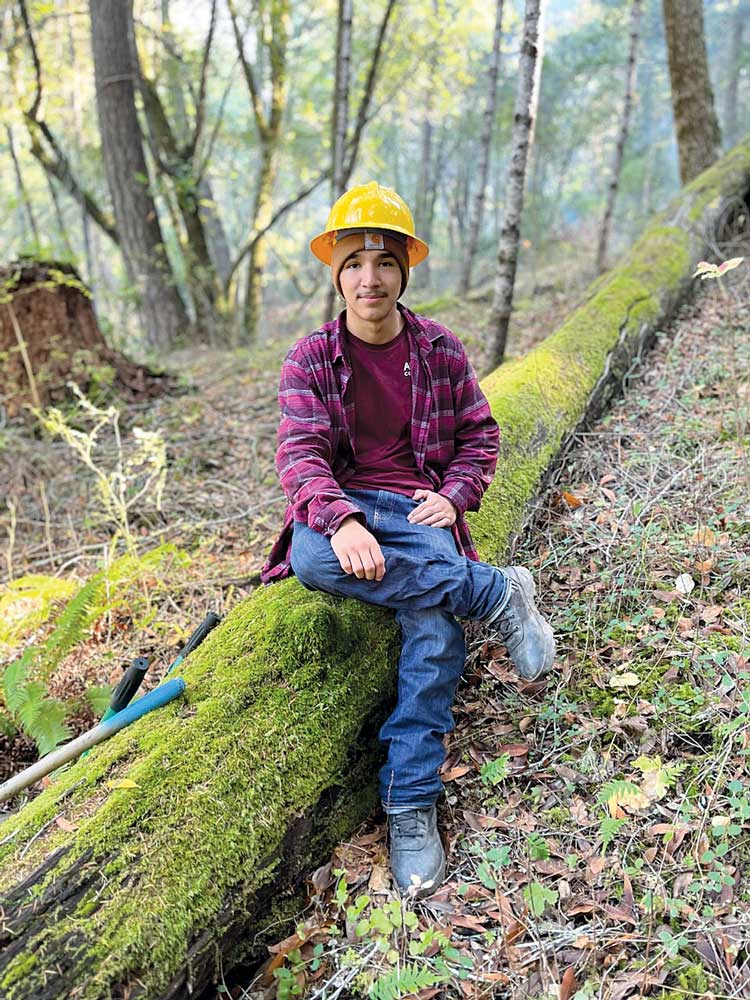
Photo by Perry Lincoln
At the January 15 event, event organizer Perry Lincoln emphasized cultural burning as a nurturing force. Good fire does not just do good to the landscape as a commodity, but for the land as a living, creative being. Kathy Mccovey, renowned basketweaver and cultural resource specialist from the Karuk tribe, demonstrated how people could, with the help of fire, enhance the success of elk populations by encouraging open visibility in the woods and abundant forage on prairies. “You’ve got your village site, and around it, the women burn a two-mile donut for a fine-grain mosaic,” she explained. “That’s for your oak woodlands and grasslands. That’s where we get our medicine plants… teas, berries. A lot of times when you burn through this oak woodland you’ll encourage those base sprouts to come out, and the elk and the deer love to nibble on that. If you manage for them, they will come.”
Bolstered by the success of the first panel, Native Health in Native Hands hosted another N-Shong Konk “Good Fire” event on February 18 featuring many community voices. Kathy Mccovey spoke again after Diana Totten, a seasoned firefighter with Wintu heritage. Another speaker was Perry Lincoln’s granddaughter, Xa-t’le T’sing (pronounced Hot-let Sink) Lincoln, who also goes by the name Star. Though Star is well-trained in western firefighting techniques, she clarified that “firefighter” is “a misleading term” for her objectives. Cultural burning was outlawed until only about a decade ago, but thanks to advocates such as Margo Robbins, Elizabeth Azuz, and the Cultural Fire Management Council, “we are working with, rather than against, fire,” said Star.
In June, Native Health in Native Hands helped a dozen Native community members become certified Firefighter IIs. This training supplemented a newly designed fire-lighting class spearheaded by Diana Totten the month prior. Titled “Cultural Fire Behavior Training,” this course was of the first in the country to provide nationally certified S-190 firefighter-foundations training specifically incorporating traditional ecological knowledge.
I attended “Cultural Fire Behavior Training” as a student. Counter to the typical, death-by-PowerPoint beginning firefighting course experience, it was taught outdoors, expanding across the landscape as its classroom, with Perry Lincoln’s points underscored by birdsong. When students asked about the importance of timing when burning different grassland ecosystems, Perry asked everyone to pay attention to who was nesting—“quail, grouse, killdeer, sandpiper, cranes.” He spoke movingly, with a tenderness born of his connection to place. “These birds, protecting their nesting places,” he implored, “how are we relating to that? That relationship, noticing the communities where we’re at, will help the animals to come back again.” For Perry, burning is made beneficial via intimate knowledge of the landscape.
Food Sovereignty Event at the Mateel
On April 28, 2023, Native Health in Native Hands hosted its third event of 2023 at the Mateel Community Center in Redway with the focus on uplifting traditional ecological knowledge. Perry Lincoln, founder and executive director of Native Health in Native Hands invited Indigenous rights activists, musicians, and educators Lyla June and Desirae Harp to help answer the questions, What is food sovereignty? How does it relate to the Landback movement, as well as recent efforts by Native Health in Native Hands to cultivate “Good Fire” in Southern Humboldt? Dr. Lyla June is an internationally renowned public speaker, poet, hip-hop artist, and acoustic singer-songwriter of Diné (Navajo) and Cheyenne lineages. Her message is centered on intergenerational and inter-ethnic healing, as well as an urgent, vibrant articulation of Indigenous philosophy.
Lincoln began by thanking Lyla June for her service to his Kinest’e people: “We’re reaching out—bringing people here to our homelands to share with us, because we’ve always been a people that helped each other.”
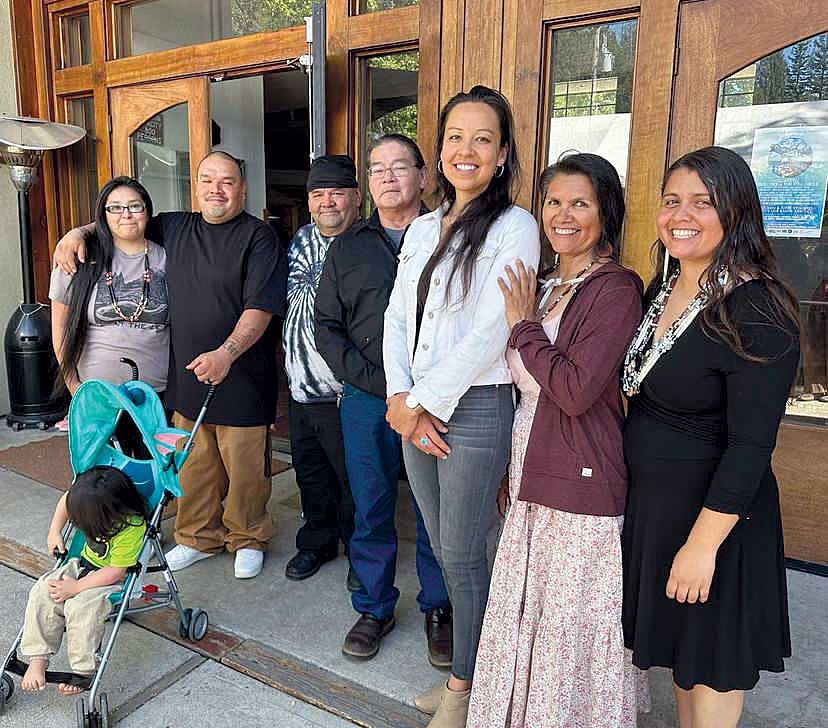
and others at the Mateel Community Center on April 28, 2023.
Photo courtesy Lyla June
June responded, “You know, they say that history is written by the victors. But how can there be a victor if the war isn’t over? Creator is sending her very best warriors and they’re coming right now to Earth to help us at this time. And in this battle, the only weapons we have, and the only weapons we need, are truth, and faith, and compassion. I’m honored to be a warrior with you all to help heal our Mother Earth.”
This event had two distinct components. First, Dr. June performed an incredible spoken-word musical set before presenting her Ph.D. dissertation, titled Architects of Abundance: Indigenous Regenerative Food Systems and the Excavation of Hidden History (this text is open-access and available online!). Her research focuses on ways in which precolonial Indigenous nations actively “gardened” the land on regional scales to produce abundant food systems. She asserted that we can “transform from the role of a leech, to the role of a keystone species that augments and supports all life around us.”
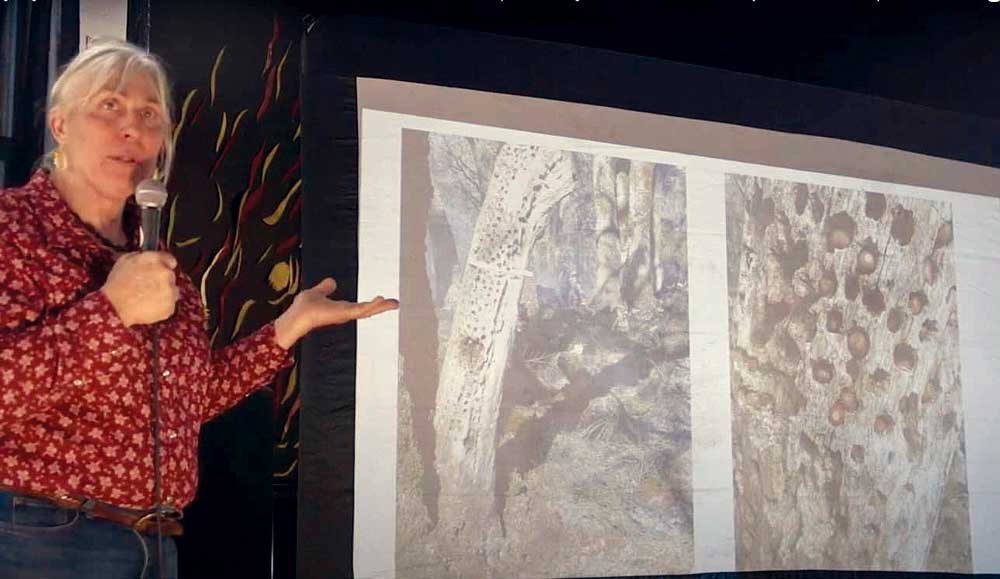
Screencap from Native Health in Native Hands on YouTube
Dr. Lyla June’s work aims to help the world appreciate the depth of knowledge of Indigenous people within land management, and value their leadership. She expressed another part of her mission at the Mateel—to help “re-educate” her own people, including her “cousins,” as she affectionately called her Wailaki audience, since Kinest’e people also speak her Athabaskan language. “A lot of us as Indigenous peoples,” she explained, “went to the boarding schools. Our parents and grandparents went to the boarding schools. And a lot of our traditional knowledge was lost. And so, what I’ve been trying to do is to excavate through fossilized pollen records, through tree-ring data, through the diaries of explorers and colonists, what did we do here and what kind of creations did we manifest through our relationships with the land? To illustrate the ways in which Indigenous peoples had a profound influence on the way the land looked and the way the land tasted.”
Dr. Lyla June reminds us that “Indigenous peoples represent five percent of the Earth’s total population, but they oversee 80% of the world’s total biodiversity.” Indeed, says Perry, “our name [of this organization] is cho-ge-xo-la-be’, which means ‘the medicine is in our hands.’” Go to www.nativehealthinnativehands.org to find out how to support Native-led ecosystem restoration in our region.
